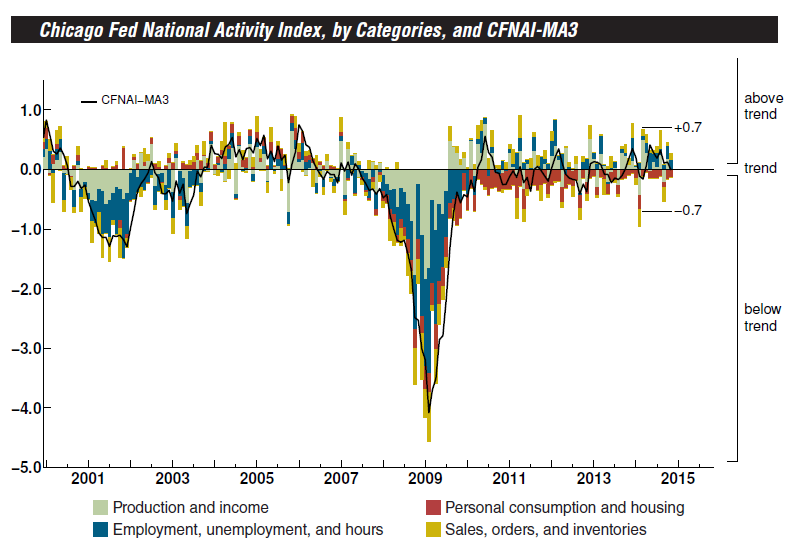Chicago Fed: US Economic Growth Slowed In October
The pace of US growth slowed more than expected in October, according to this morning’s update of the Chicago Fed National Activity Index. The three-month moving average for this benchmark of 85 indicators slipped to a negative 0.01 reading last month from +0.12 in September. Led by weakness in “production-related indicators,” today’s release “suggests that growth in national economic activity was near its historical trend,” according to the press release.
Although the US economy continues to expand, albeit at a middling pace, the lesser rate of growth in recent months is a bit worrisome at a time when the macro trend around the world is looking challenged. Slower growth in China, along with a new recession in Japan and ongoing stagnation in Europe, will remain headwinds for the US in the months ahead. It’s unclear how much of a price the US will pay in terms of slower growth, although last week’s November update on sentiment in the manufacturing sector suggests that the offshore blowback is starting to bite, albeit mildly so far.
Today’s data from the Chicago Fed tells us that a broader deceleration is also unfolding for the US economy overall. The downshift is slight and, for the moment, looks unthreatening in terms of the implications for the business cycle in the near term. But if that view is too rosy, we’ll see the evidence in the upcoming economic releases, including tomorrow’s update on consumer confidence via the Conference Board. On Wednesday, the government publishes October numbers on personal income and spending, although the consensus forecast anticipates a round of moderate gains, according to Econoday.com.
For now, there’s a good case for managing US macro expectations down a notch. That still leaves plenty of room for optimism. Forward momentum across a broad set of indicators continues to signal that growth will roll on for the foreseeable future. But with risk factors swirling around the globe, it’s fair to say that the near-term outlook for the US is slightly more vulnerable to downside revisions.
The next big test is comparing the full set of numbers for November vs. last month. It’s still too early to make even speculative guesstimates on this front, but clarity is coming, in daily doses. Meanwhile, keep your eye on the canaries in the coal mine. “The manufacturing sector would likely be the first place where the effects of slower global growth would creep into the U.S. economy, but thus far the factory sector has held up in the face of headwinds,” according to Wells Fargo.
Maybe, although one could argue that last week’s report via Markit Economics offers a slightly different perspective. In addition to the softer data in the flash November estimate for the manufacturing purchasing managers index (PMI), we have a similar deceleration to consider in today’s update of the services PMI numbers for this month. Markit’s chief economist, Chris Williamson, explains:
“A fifth-consecutive monthly slowing in growth in the services sector adds to signs that the economic upturn has lost considerable momentum, though it’s important to note that the pace of expansion remains robust by historical standards.”
Disclosure: None.
Comments
 No Thumbs up yet!
No Thumbs up yet!




